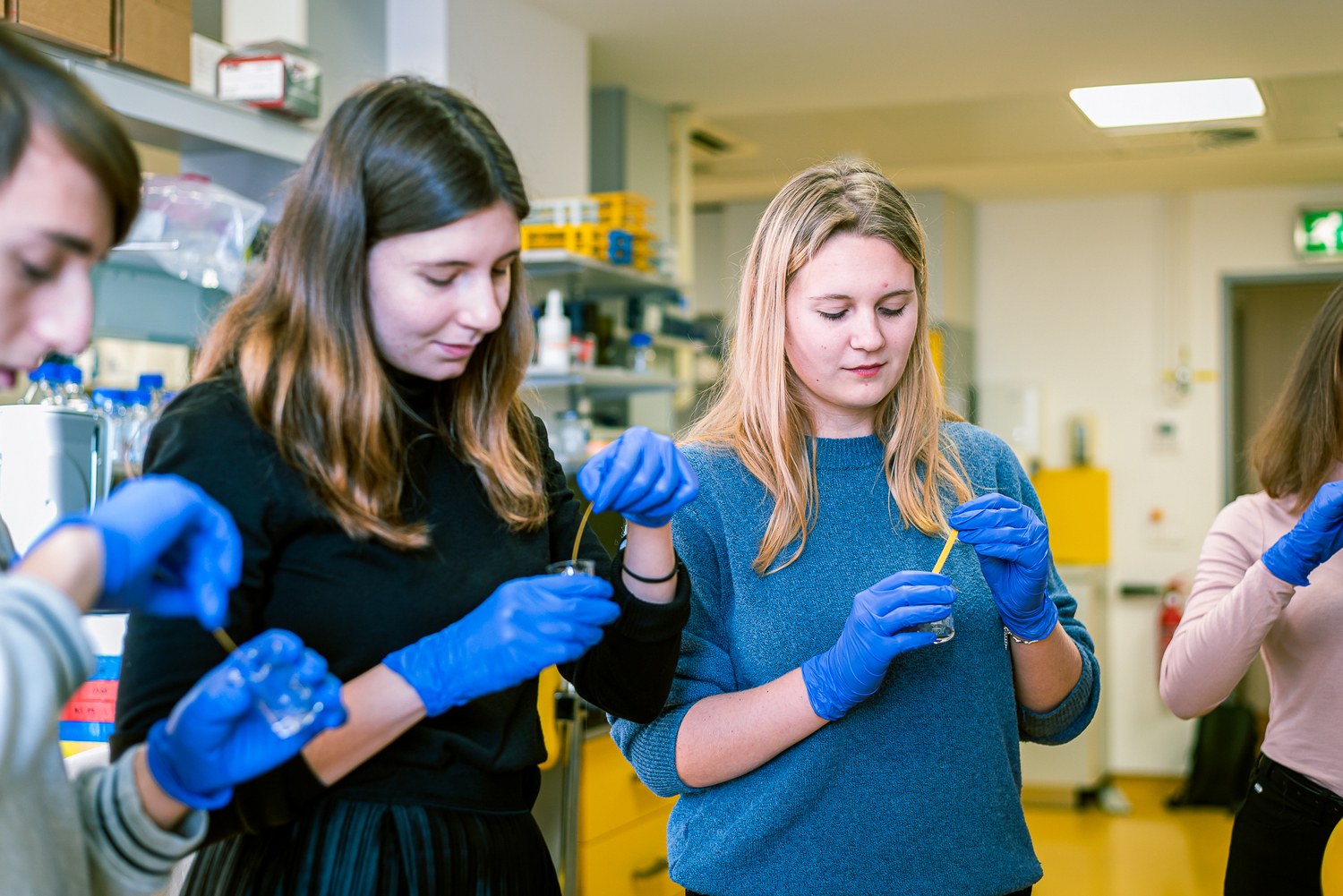Excursions for English-speaking school classes (Week of the Czech Academy of Sciences)

As part of the Week of the Czech Academy of Sciences at IOCB, we offer excursions to our labs for English-speaking school classes (for students 13+).
School groups are welcome to come to see our laboratories on Friday, 4 November from 9 am to 12 pm.
(If you are interested in other Week of the Czech Academy of Sciences events at our institute, please go here [in Czech].)
Organization
Excursions are intended for students from the age of 13 (8th grade of elementary school and 3rd grade of 8-year high schools).
For safety and practical reasons, a maximum of 13 persons, incl. the teacher, can participate in each presentation. If you are planning to come with a larger group of students, you will need to split them into smaller groups and book a separate program for each of them.
Registration
- The link to the registration form will be posted here on 6 October after 3 pm.
Program
Colors helping scientists
How do you know which berries are ripe and which are better not to eat? Or how to tell an red amanita mushroom from a Penny Bun at a distance? It is because we see colors. Even scientists use light and color for scientific discoveries. In our lab, you'll see smart chemicals that change color to show us what's going on at the molecular level.
Drug discovery
Developing a new drug is not an easy and quick process. Where does one start? What are the criteria that a molecule has to meet in order to become a drug? Together we will take a close look at the process of developing a drug.
Fluorescence in action
Fluorescence is the ability of molecules to emit colored light. This phenomenon often accompanies scientists on their first steps on the path to drug development. These drugs are most often targeting enzymes, i.e., molecular machines that catalyze chemical reactions in living organisms. In our laboratory, you can see with your own eyes how we use fluorescence to purify enzymes and test potential drugs.
Microscopy and microscopes
History of microscopes, from Leeuwenhoek to nowadays.
Neurosteroids in health and disease
Neurosteroids are synthetic derivatives of naturally occurring steroids that play important role in physiology as well as in disease. We will explain difference between steroids that act as hormones (estradiol, testosterone) and neurosteroids that can be used as drugs for treatment of various diseases of central nervous system. We will talk about neurosteroid allopregnanolone, the first-in-class drug approved in 2019 for treatment of post-partum depression and other novel neurosteroids that are currently tested in various human clinical trials.
The secrets of elements
Have you ever wondered if your golden ring is truly made of gold? In our laboratory you will see methods capable of finding out. Methods for investigation of elemental composition often use light or radiation. When samples are excited using X-rays, flame or even argon plasma hotter than the surface of the Sun, they emit a characteristic radiation, which bears information about elements present in the sample and their amounts. Come and be excited too!
The world of RNA vaccines
How does the cell use its basic mechanisms to fight infectious diseases? RNA molecules play many important roles in the cell. The best known is the transfer of genetic information from DNA to the part of the cell where protein synthesis occurs. They therefore function like an imaginary recipe in a huge DNA cookbook. It is therefore likely that RNA played a key role in the origin of life on Earth. In addition, these natural molecules can easily be prepared under laboratory conditions. The fact that RNA is intrinsic to the body and that a suitable recipe for synthetizing any protein can be written into it offers great hope for the development of gentle and effective next-generation vaccines. Come and learn more about these exciting molecules!
The world oldest social insects and their extraordinary chemical world
Already in deep prehistory, in the shadow of the dinosaurs, the first termite mounds began to grow. These initially seemingly insignificant creatures gradually occupied the entire tropical zone, where they took over the role of the main wood decomposers. For over a hundred million years in their dark world, termites have perfected communication through smells, invented ever new chemicals for their military arsenal and even set the foundations of agriculture by growing mushrooms. Thanks to their resilience, they have survived every catastrophe, and today they keep our planet's forests in functional state. Come and see their fascinating world - either in our simulated rainforest or in our ethology lab.
Unknown DNA
When we say DNA, most of us will probably imagine a nice double-helix and think about genes. However, DNA can display also other less traditional functions. These are in the scope of our lab’s interest, and we consider them interesting enough to spread their fame publicly. During our session, we will show you how we find such short specific DNA sequences able to trigger a chemical reaction. Moreover, you will prepare some of the reactions with your own hands and observe their progression using several techniques, which we routinely use in our research.
Viruses: knowing the enemy
We will introduce the most interesting viruses of the world and talk about the laboratory and personal safety procedures when working with hazardous viruses. We will show you the video from bio-safety level 3 laboratory where we work with viruses and search for the new therapeutics against viral-caused diseases.




